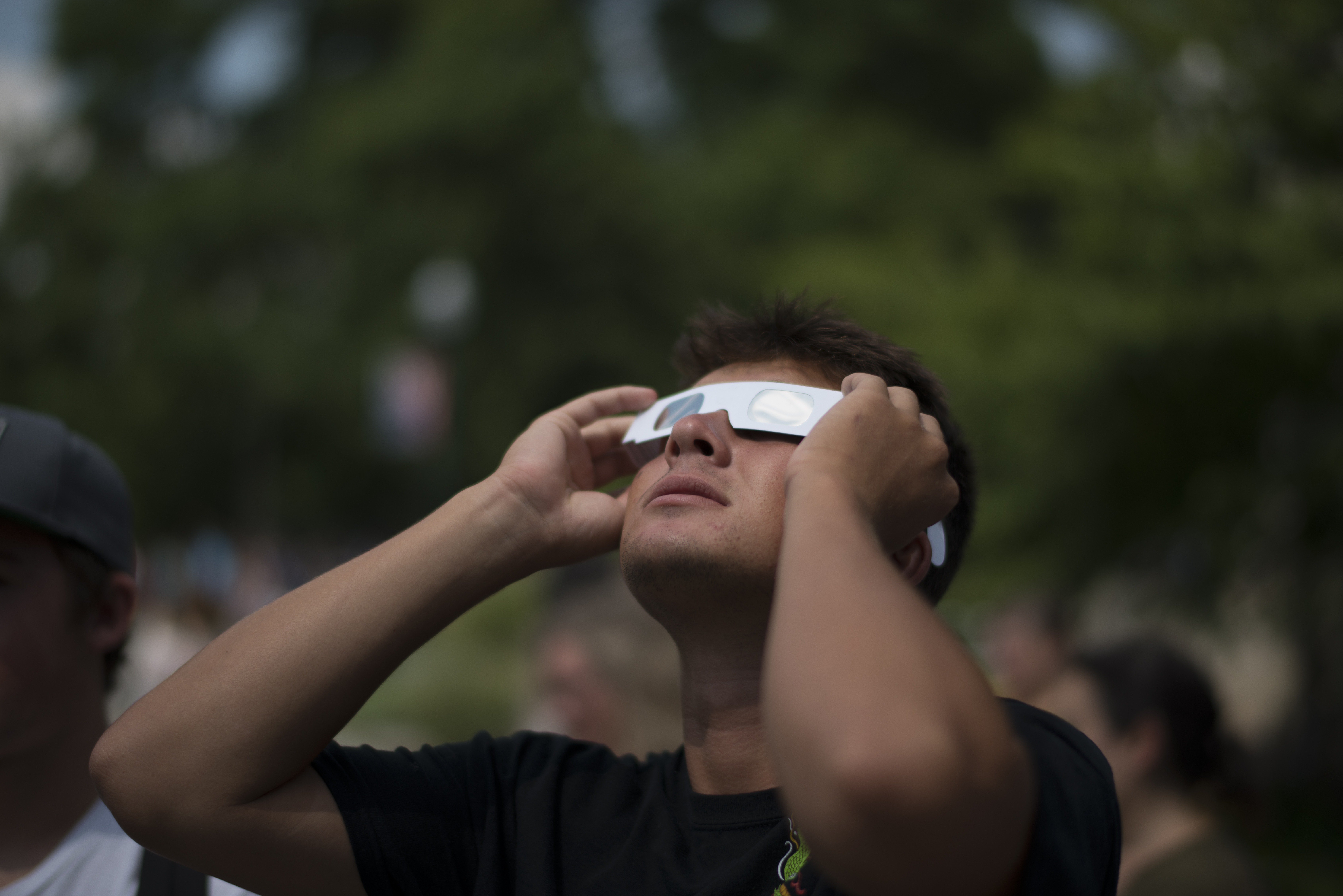San Diegans paused and look up on Monday (with their safety glasses) to experience part of a total solar eclipse that darkened a strip of North America for the last time in 20 years.
The eclipse first darkened Mexico as the moon crosses in front of the sun in perfect alignment with the Earth. Then, it crossed into the United States through Texas creating a path of darkness northeast to Maine. For other contiguous states not in the "path of totality," like San Diego, a partial solar eclipse was still be visible.
San Diego County was one of the best places in California to experience the event. Another total solar eclipse won't be visible from the contiguous U.S. until Aug. 23, 2044.
"From San Diego's point of view, at maximum coverage about 55% of the sun will be covered so it will still be a noticeable difference if you're lucky enough to be watching it through eclipse glasses or something safe," said the Fleet Science Center's resident Astronomer, Lisa Will.
Get top local stories in San Diego delivered to you every morning. Sign up for NBC San Diego's News Headlines newsletter.
Here's what to know about the cosmic event, including some happenings around the county.
Here's where to find free solar eclipse-viewing glasses in San Diego County
What is a total solar eclipse?

A solar eclipse occurs when the moon passes directly between the Earth and the sun, causing the moon's shadow to fall on the Earth. There are total solar eclipses, where the moon completely blocks out the sun, and annular solar eclipses, when the moon is furthest from Earth and doesn't fully block out the sun. The last one of those was in October.
Stargazers in 15 states will get the full effect of the eclipse, plunging into total darkness, while in San Diego, the moon will cross between the Earth and the sun at an angle that obscures about 55% of the sun, creating a partial total solar eclipse.
North America won’t experience totality again until 2033, but only in Alaska. The next for the contiguous U.S. isn't until 2044, when totality will be confined to Western Canada, Montana and North Dakota. There won’t be another U.S. eclipse, spanning coast to coast, until 2045.
Solar Eclipse
What time is the eclipse?
The eclipse will begin in the U.S. at about 12:30 p.m. CT on Apr. 8 when it moves into Southwest Texas. For those in the path of totality — the part of the eclipse where the moon completely obscures the sun -- there will be complete darkness for two and a half minutes.
Here in San Diego, the partial solar eclipse will begin at 10:03 a.m. PT when the Moon appears to touch the Sun's edge. The climax, when the Moon is closest to the center of the Sun, will be visible from San Diego at 11:11 a.m. Viewers will see the most exciting moments between 10:45 and 11:45 a.m., with the eclipse concluding at 12:23 p.m. when the Moon leaves the Sun's edge.
What is the path of the eclipse?
The eclipse's "path of totality" will start in Southwest Texas and move through Oklahoma, crisscrossing the Midwest, Mid-Atlantic and New England, before exiting over eastern Canada into the Atlantic.
The period of totality refers to the time during a total eclipse when the moon completely obscures the sun. The period of totality is usually brief, lasting just a few minutes.
Fifteen U.S. states will get a piece of the action, albeit two of them — Tennessee and Michigan — just barely. Among the cities smack dab in the action: Dallas; Little Rock, Arkansas; Indianapolis, Cleveland, Ohio; Buffalo, New York; and Montreal — making for the continent’s biggest eclipse crowd. About 32 million people in the U.S. live inside the 115-mile-wide path of totality.
Don’t fret if you don’t have front-row seats. Practically everyone on the continent can catch at least a partial eclipse. The farther from the path of totality, the smaller the moon’s bite will be out of the sun. In Seattle and Portland, Oregon, about as far away as you can get in the continental U.S., one-third of the sun will be swallowed.
NASA will also provide a livestream of the eclipse.
How to safely watch a solar eclipse
It is never safe to look directly into the sun, even if it's partially obscured. Anyone watching an eclipse must wear special eclipse glasses at all times if facing the sun, or must use an alternate indirect method, NASA says.
Solar eclipse glasses "actually have a mylar film that makes it safe to look through them and look up at the sun," Will said. "As much as we want you to go look out at the eclipse, make sure you do so safely, Will said. "We just don't want you to hurt your eyes."
Some San Diego locations are giving away or selling solar eclipse glasses. For more information, click the link below.
Here's where to find free solar eclipse-viewing glasses in San Diego County
If you're viewing the eclipse through a telescope, you must have a solar filter attachment.
You can also use projection by filtering sunlight through a small hole or aperture and then looking at the sunlight's shadow on the ground or a wall, Will said.
Learn more about eye safety during solar eclipses on NASA's website.
Are there any eclipse events?
If you can see the sun, you can see the eclipse, but don't forget your safety glasses, Will said.
Several locations across San Diego County are also hosting free events and will dole out glasses or help you build your own viewing tools for the eclipse. Will herself will be at the Fleet Science Center for a viewing party. Here are a few events happening in San Diego County:
Join the San Diego Fleet Science Center for a viewing party in the heart of Balboa Park (near the fountain) starting at 10 a.m. Scientists will be on hand to answer questions and teach guests how to make their own solar viewers. Guests can purchase a pair of NASA 3-D eclipse classes from the Fleet's gift shop.
"It shows you how interested the public actually is in science and I think the public just wants a place to go where they know they can get good information and that's something that we can do for them here at the Fleet Science Center," Will said.
Inside the museum, the Fleet's IMAX theater will be showcasing a live stream of the total eclipse from the path of totality, where complete darkness will fall over parts of the U.S. Tickets must be purchased to experience this part of the event.
🌘 San Diego Public Libraries
Each of the 37 San Diego Public Library locations have received a limited supply of solar eclipse-viewing glasses to be distributed to the public, a library spokesperson confirmed.
Guests do not need a library card to obtain the glasses, but they are in very short supply -- and some branches may even be sold out already. Guests will be limited to two pairs of glasses per household.
Several branches are also hosting their own free events for leading up to or during the total eclipse.
- At the Balboa Library on April 3, guests can create their own eclipse viewers out of a cereal box for the event starting at 3:30 p.m.
- The Pacific Beach/Taylor Library will host their own viewing party on the Cass Street Plaza. Thre will be activities and viewers to share.
- Let your little ones learn about the eclipse at a special storytime at the Carmel Mountain Ranch branch libary on April 3.
- For a full list of events, click here.
Why are eclipses so exciting?
"There is actual interesting science that you can do during eclipses," Will said. "Eclipses have been a subject of humanity's interest for a long time. Especially, you can imagine what would happen if you felt the sun disappeared for a couple of minutes and you weren't expecting it. Now that we can predict it, they're less mysterious but still fascinating."




